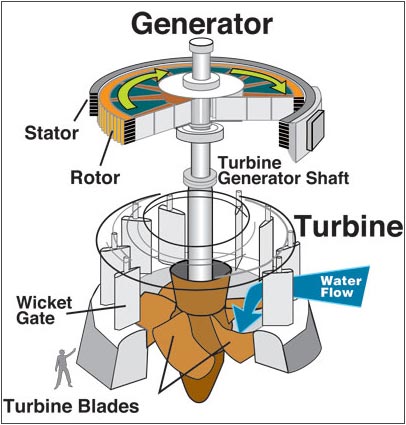-Read More-
-Read Less-


Reservoir and Dam
Reservoirs and dams work together to control, store and manage the water flow to a hydroelectric generating station. Brookfield Power has more than 2,300 GWh of storage capacity in the reservoirs behind many of its dams, providing significant operating flexibility to respond to market needs and protect against short-term changes in water supply.

Gate House and Spillway
The gate house in a hydroelectric facility encloses gates that can be raised or lowered to control the flow of water from the dam to the turbines to generate power. The spillway contains movable gates, which facilitate the passage of water through the dam during periods of high flow.

Powerhouse
The powerhouse contains turbines, generators and associated equipment used for the production of electricity.

Turbines
Water travels to the powerhouse and turns the large blades of a turbine attached to a shaft and generator. The spinning shaft turns magnets inside the generator to produce electricity. The water that was used to produce electricity then flows back to the river.

Breaker Room
The equipment in the breaker room controls and switches the electricity produced inside the powerhouse, before it is delivered to the substation for step-up and transmission to the power grid.

Substation and Surge Tanks
Once electricity is produced, it moves through power lines to a substation where transformers increase the voltage to move it across transmission lines. From here, electricity is delivered to contracted power customers or to electricity markets throughout North America. Surge tanks help to buffer and regulate the flow of water to the turbines.

Aerial View of Hydroelectric Generating Station and Substation
Here is the view from above the hydroelectric generating station and substation where the power production process ends and transmission begins. Electricity produced within the generating station is transmitted into the power grid as well as directly to industrial customers. Approximately 75% of Brookfield’s average annual generation is sold under long-term power sales agreements with the remaining generation dispatched in competitive, bid-based markets in Ontario, New York and New England.

Control Room
From a control room, operators can control and monitor the equipment of the generating facility, the flow of water through the dam and the generation of electricity. This function can also be automated through a remote control room, which operates multiple generating facilities.

Remote Control Room
The remote control room, operated 24 hours a day, 7 days a week, allows system operators to control and monitor generation of all hydroelectric generating stations connected to that system and to relay that information back to the trading and marketing group. From the remote control room, an operator can start and stop generators, control the release of water through the system and many other functions from hundreds of kilometres away.

Trading and Marketing
Brookfield Power's trading and marketing platform is operated 24 hours a day, 7 days a week. Housed in our corporate office in Gatineau, Quebec, our experienced team is responsible for efficiently and strategically optimizing the sale and delivery of power produced by our operations to the marketplace.
 Autorotate
Autorotate Help
Help Maps
Maps Gyro
Gyro Share
Share VR Headset
VR Headset











